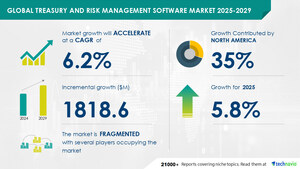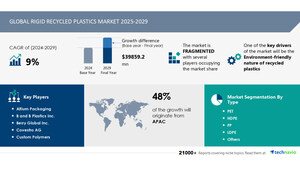NEW YORK, May 31, 2024 /PRNewswire/ -- The global textile machinery market size is estimated to grow by USD 10.71 billion from 2024-2028, according to Technavio. The market is estimated to grow at a CAGR of almost 6.74% during the forecast period.
For more insights on the forecast market size and historic data (2018 - 2022) - Download Free sample report in minutes
Forecast period |
2024-2028 |
Base Year |
2023 |
Historic Data |
2018 - 2022 |
Segment Covered |
Product (Spinning machinery, Knitting machinery, Weaving machinery, Texturing machinery, and Finishing and other machinery), End-user (Garment and apparel factory, Cotton and wool mills, Home textile, and Technical textile), and Geography (APAC, Europe, North America, Middle East and Africa, and South America) |
Region Covered |
APAC, Europe, North America, Middle East and Africa, and South America |
Key companies profiled |
ATE Pvt. Ltd., Batliboi Ltd., Camozzi Group SpA, KARL MAYER Holding SE and Co. KG, Lakshmi Machine Works Ltd., MURATA MACHINERY USA, INC., OC Oerlikon Corp. AG, Qingdao Jingtian textile machinery co.,Ltd, Qingdao Lebon Industry Co., Ltd., Radici Partecipazioni Spa, Rieter Holding AG, Santex Rimar Group, SAURER AG, SHIMA SEIKI MFG., LTD., Tessenderlo Group NV, Toyota Industries Corp., Trutzschler Group SE, TSUDAKOMA Corp., VANDEWIELE NV, and YAMUNA MACHINE WORKS LTD |
Key Market Trends Fueling Growth
Textile machinery automation is transforming the textile industry by enhancing product quality and cost competitiveness. In fiber manufacturing, automation ensures consistent production of various fiber types by monitoring diameter, polymer characteristics, temperature, and tension. Automation in yarn manufacturing improves homogeneity and reduces unevenness through advanced systems like chute feed systems, auto levelers, auto-corners, and splicing.
Weaving and dyeing processes also benefit from automation, optimizing production and ensuring accurate monitoring of ingredients, water levels, temperature, and time. Overall, automation in textile machinery is reducing labor costs, increasing efficiency, and improving product quality, driving the growth of the global textile machinery market.
The textile machinery market is experiencing notable advancements in technology. Three-dimensional printing is gaining traction in the industry, with producers focusing on printing textiles. Nanotechnology is another trend, with decortication and digitization being key areas of application. Laser technology is used for senory printing, while automation and robotics are streamlining production processes.
Comfort and sustainability are driving factors, with fibres and finishing techniques being areas of innovation. Traditional processes such as spinning, weaving, and dyeing are being enhanced through technology. Producers are also focusing on improving productivity and reducing costs through process optimization.
Market Challenges
- The textile machinery market experiences challenges due to the high upfront costs of acquiring and installing advanced equipment, particularly for small and medium-sized enterprises (SMEs). This financial barrier hinders SMEs from adopting modern technology, creating an uneven competitive landscape.
- Large firms with greater financial resources have an advantage. Solutions include financing options, government incentives, and industry collaborations to encourage SMEs' use of sophisticated textile machinery. This significant initial investment may negatively impact the market's growth during the forecast period.
- The Textile Machinery Market faces several challenges in the current business environment. These include the need for cost reduction and efficiency gains, increasing competition, and the adoption of new technologies. Producers must stay up-to-date with the latest production processes and technologies to remain competitive. Fiber production, processing, and finishing techniques are constantly evolving, requiring significant investment in research and development.
- Additionally, the trend towards sustainability and eco-friendly practices is driving demand for new and innovative textile machinery solutions. The challenge lies in balancing the need for innovation with the need to keep costs down and maintain profitability. The market is also subject to regulatory pressures, particularly in areas such as labor laws and environmental regulations. Overall, the Textile Machinery Market requires a strategic approach to remain competitive and profitable in the face of these challenges.
Research report provides comprehensive data on impact of trend, driver and challenges - Download Free sample report in minutes
Segment Overview
- Product
- 1.1 Spinning machinery
- 1.2 Knitting machinery
- 1.3 Weaving machinery
- 1.4 Texturing machinery
- 1.5 Finishing and other machinery
- End-user
- 2.1 Garment and apparel factory
- 2.2 Cotton and wool mills
- 2.3 Home textile
- 2.4 Technical textile
- Geography
- 3.1 APAC
- 3.2 Europe
- 3.3 North America
- 3.4 Middle East and Africa
- 3.5 South America
1.1 Spinning machinery- The textile machinery market is driven by the increasing demand for spinning machinery, particularly short-staple spindles, used in converting processed fibers into fine threads for textile manufacturing. Key Asian countries, including China, India, Vietnam, Turkey, and Indonesia, are major investors in this segment due to rising fiber production. China, India, Vietnam, Bangladesh, Indonesia, and Pakistan lead in installed capacities for short-staple spindles. Cotton-spinning powerhouses like China, India, Pakistan, Turkey, Bangladesh, and Vietnam contribute significantly to global cotton spinning. This trend is expected to continue, fueling the growth of the global textile machinery market.
For more information on market segmentation with geographical analysis including forecast (2024-2028) and historic data (2018 - 2022) - Download a Sample Report
Research Analysis
The Textile Machinery Market is experiencing significant growth due to the automation of textile production processes in multinational firms. Robots and advanced technology, including Plasma technology, Biotechnology, and Nanotechnology, are revolutionizing the industry. New machinery in spinning, weaving, dyeing, finishing, and digitalization are increasing productivity and sustainability in the global market.
Key technologies like Laser printing, 3D printing, and Non-woven fabrics made from Polyester fiber are driving innovation and expanding the application areas of textile products. The integration of these advanced technologies is transforming the textile industry and creating new opportunities for textile producers.
Market Research Overview
The Textile Machinery Market encompasses a wide range of machinery and equipment used in the production and processing of textiles. These include spinning, weaving, knitting, dyeing, finishing, and printing machines. The market is driven by factors such as increasing demand for textiles in various industries, technological advancements, and automation in textile production. The global textile industry is a significant contributor to the economy, with major markets in Asia, Europe, and North America.
The market is competitive, with numerous players offering a diverse range of products to cater to the specific needs of customers. The use of sustainable and eco-friendly technologies is a growing trend in the market, as consumers and regulators demand more environmentally friendly production methods. The market is expected to grow at a steady pace in the coming years, driven by these factors and others.
Table of Contents:
1 Executive Summary
2 Market Landscape
3 Market Sizing
4 Historic Market Size
5 Five Forces Analysis
6 Market Segmentation
- Product
- Spinning Machinery
- Knitting Machinery
- Weaving Machinery
- Texturing Machinery
- Finishing And Other Machinery
- End-user
- Garment And Apparel Factory
- Cotton And Wool Mills
- Home Textile
- Technical Textile
- Geography
- APAC
- Europe
- North America
- Middle East And Africa
- South America
7 Customer Landscape
8 Geographic Landscape
9 Drivers, Challenges, and Trends
10 Company Landscape
11 Company Analysis
12 Appendix
About Technavio
Technavio is a leading global technology research and advisory company. Their research and analysis focuses on emerging market trends and provides actionable insights to help businesses identify market opportunities and develop effective strategies to optimize their market positions.
With over 500 specialized analysts, Technavio's report library consists of more than 17,000 reports and counting, covering 800 technologies, spanning across 50 countries. Their client base consists of enterprises of all sizes, including more than 100 Fortune 500 companies. This growing client base relies on Technavio's comprehensive coverage, extensive research, and actionable market insights to identify opportunities in existing and potential markets and assess their competitive positions within changing market scenarios.
Contacts
Technavio Research
Jesse Maida
Media & Marketing Executive
US: +1 844 364 1100
UK: +44 203 893 3200
Email: [email protected]
Website: www.technavio.com/
SOURCE Technavio

WANT YOUR COMPANY'S NEWS FEATURED ON PRNEWSWIRE.COM?
Newsrooms &
Influencers
Digital Media
Outlets
Journalists
Opted In





Share this article